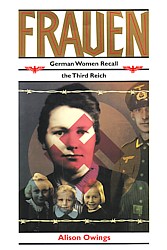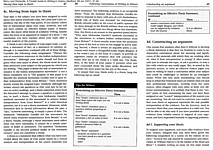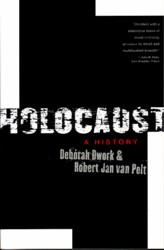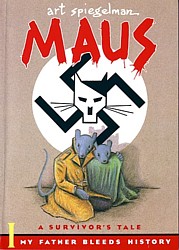| Old
Announcements
(back to top)
- Dec. 12, 2007: Book Order. There are four course books
for Winter 2008. You can save a fair amount of money by ordering them online
and used--see links in the table below:
- Dec. 13, 2007: Crashing. This course
is currently closed, with 11 students on a waitlist. Four spaces have opened
up already, and I'd guess at least 4-6 more will become available as students
finalize their schedules at the beginning of the quarter.
Students enrolling concurrently in my Hist
133Q seminar will be given priority on the waitlist.
- Jan. 8, 2008: Waitlist. Hist 133D
now has 1 open spot, 3 no-shows in the first class, 4 waitlisted students
with priority, and 5 more waitlisted students, 2 of whom may have priority
status. Thus it is very unlikely that anyone not already on the waitlist
will be able to enroll.
The 2008 Hist 133D syllabus
is now available online.
- Jan. 9, 2008: Textbook availability. Several students
who ordered the textbook online have not yet received it. That book (and
the other course books) are on 2-hour reserve at the UCSB library. Especially
for chapter 1, that should be sufficient until your books arrive.
- Jan 16, 2008: Q1 due Thursday, 1/17. In a blue book,
on the first right-hand page:
5-7 bullet points on the causes of (just one of a, b, or c):
- Vladek's survival, OR
- Why "people" (which?) hunted & murdered Jews, OR
- Why "people" (which?) helped Jews.
- Be sure to cite specific panels, giving volume & page numbers,
for example (I, 16).
- The questions on the Maus
handout
are available online as well (see questions section).
- Jan. 21, 2008:
- I've started the Books for
Essay page.
- This Thursday (1/24) Sobibor survivor Thomas Blatt will be speaking
to our class. As preparation, please read this student
review of Escape from Sobibor, a book by Richard Rashke upon
which the 1987 film Escape from Sobibor is based.
- Register to vote--last chance. January 22nd, is the
last day to register to vote for the Feb. 5"Super Tuesday" presidential
primary election. It's too late to register online, but you still have
time to do it the old fashioned way and mail it in as long as it is postmarked
by tomorrow, Jan. 22. Go to the California Secretary of State's website
to print out a registration form and mail it to your local county elections
officia:l: https://ovr.ss.ca.gov/votereg/OnlineVoterReg/
If you plan on being at UCSB to vote next November, this is worth
doing now.
- (1/21/08) Feb. 20, 2008, 6-9pm: The required film
Uprising (about the Warsaw ghetto uprising), will be shown in
1930 Buchanan on Wed. evening, 2/20. If you can't make
that showing, see the professor to make alternate arrangements (borrow
his or rent a VHS/DVD copy).
- note 1/21/08: as I announced in class last Thursday when I handed out
the blue Book Essay assignment sheet,
having the essay due the day after the film showing is NOT a good idea.
Thus the book essay due date will be Tuesday, 2/19/08, 12:30pm.
- Jan. 24-Feb. 2, 2008: Santa Barbara International Film Festival.
There are four films being screened that have Holocaust themes (thanks
to Mackenzie for the reminder):
- THE
COUNTERFEITERS is the true story of historys
largest counterfeiting operation. Set up by the Nazis in 1936 under the
name Operation Bernhard, the plan was to counterfeit the currency of enemy
nations in an attempt to weaken their economies while filling the empty
war coffers. (98 mins; link;
25th-7:30, 26th-11am, 27th-7:30)
- A Jewish Federation
of Greater Santa Barbara Film by Louise Palanker and Jennifer A. Reinish,
WE PLAYED MARBLES features eleven local Holocaust
survivors who recount memories of their childhoods in Austria,
Czechoslovakia, Germany, Hungary and Poland. Their stories illuminate the
rich European Jewish culture that was systematically destroyed by Nazi
tyranny. These Santa Barbara residents - now in their 70s and 80s - share
memories of how their lives were abruptly and forever changed by dramatic
historic events. (75 mins; link;
26th-7pm)
- Narrated by Angelica
Aragon, this is a thoughtful, sensitive and moving story of two women whose
disparate paths cross. In the process, they reconstruct what has been lost
in order to understand their future. Award-winning director, Guita Schyfter,
returns to documentary film for a personal exploration of memory, origins,
and the intersections of conflicting identities in LABYRINTHS OF
MEMORY. The film interweaves Schyfters story—a journey to
Russia and Costa Rica to comprehend the lives of her parents, orphaned
Jews displaced by the Holocaust—and that of Maité Guiteras,
the twice-adopted daughter of famous Cuban anthropologist Calixta Guiteras,
as she returns to Chiapas, Mexico to find her birth mother. (95 mins.;
link;
30th-12:30, 1st-7pm)
- Nominated for four
Israeli film awards, THE DEBT is a cat-and-mouse espionage
thriller set in Israel in the mid-1990s. Rachel is a comfortably retired
Mossad agent, having recently penned her memoirs. Thirty years earlier,
she and her fellow agents, Zvi and Ehud, were honored for hunting, capturing
and killing a malevolent Nazi war criminal, the "Surgeon of Birkenau."
During the book launch party, Zvi re-emerges, telling Rachel that a frail,
perhaps delusional, man in a nursing home in Kiev is now claiming to be
the surgeon. (93 mins; link;
31st-4:30, 1st-7:45, 2nd-4:30)
- Jan. 24, 2008. Yikes! So much going on, it's hard
to keep track:
- For more information on Sobibor, see Thomas Blatt's
website: www.sobibor.info. It has
his and the Sobibor uprising story and documents on 15 pages.
- If you would like to write him a note with your thoughts about the
Sobibor uprising and his presentation, I will pass it along to him. He
appreciates receiving feedback. As you know, he has made it his life's
work to inform the world about the uprising.
- Expect Q2 on Sunday, about the 4 interviews on eres
(password: rhythm), to be due in class on Tuesday. I will e-mail it.

- Jan. 28, 2008, 5:30pm, downtown at 524 Chapala
St: required Monday evening lecture by Alison Owings, author of Frauen:
German Women Recall the Third Reich (website
of talk). Readings on eres,
password: rhythm.
The author will answer questions in our class on Jan. 29.
- Jan. 28, 2008: For question 2, which
you should try to fit on the second page of the bluebooks, you should write
a paragraph each on THREE of the four interviews from Alison Owings' book
that is available on eres
(password: rhythm).
- Each of the 3 paragraphs should highlight a main point of your choosing
from that woman's narrative about Nazi Germany. If you need ideas, perhaps
think about why the author included it in the collection, or what "lesson"
a reader might draw from her experience under Nazism. Or maybe reflect
about some unexpected, non-stereotypical thing that you learned, or something
puzzling that came up in the story.
(PS. As usual, part of the purpose of this is to show me that you've read
the assignment, the other part is to prepare you for discussion in class
on Tuesday. But it'sjust a short paragraph, not a dissertation!)
- Finally, if you'd like to learn more about Ms. Owings' and her current
work, you can visit her website,
or a recent
blog posting she wrote, which includes some biographical information.
- Directions for tonight: The Jewish Federation is at
524 Chapala St., between Cota and Haley (google
map). Driving from UCSB, take the CaRillo exit from the 101, go over
to and down Chapala. The lot in front is apt to be full, so park on the
street, or around the corner on Haley or Cota. If you are taking the bus,
the 24x leaving the UCSB bus loop at 4:36 or 4:52 (arriving at bus
station on Chapala 4:58 or 5:14) will get you there in time (5 blocks walk
down Chapala). Bus fare is free with student ID. If anyone would like a
ride back, I can take up to 4 people, although I will be one of the last
to leave the talk. Or if you can't get a ride with someone else, the 7:30
bus from the transit center arrives at UCSB at 7:48.
- Feb 4, 2008, 9:30pm: Ok, I've received enough e-mails
about Q3 that I'll give you a big hint.
- We'll take the first few minutes of class to write it. It will be
based on chapter 4 of the textbook, and you should be able to name and
BRIEFLY describe three events in the 1930s that paved the way to Kristallnacht
in Nov. 1938. The description should relate the event to Kristallnacht
in some way.
- Example (not in the textbook): The ordinance of April 26, 1938 stipulated
that all Jewish Germans had to register their assets with the government.
This enabled bureaucrats all over Germany to compile lists of wealthier
Jews who could be arrested and held for ransom.
- There are a couple of very obvious choices, and some less obvious ones.
- PS. The state requires the UCs to encourage students to vote,
so let me remind you that tomorrow is not only the presidential primary
day, but there are some state ballot initiatives, esp. prop. 92, which
affects community college funding. By the way, even if you "declined
to state" your party preference, you are allowed to vote in the democratic
primary. To find out how, check out Agnes
& Myrtle on youtube.
- Feb. 7 event (Thu., 8pm): James Carroll, Op-Ed columnist
for the Boston Globe and author of several award-winning books:
"The Disputation: Christians Arguing with Christians about the Jews"
Thursday, February
7 / 8:00 p.m. / Free / UCSB Campbell Hall
Anti-Semitism is a Christian problem, not a Jewish problem. The medieval
"disputation" pitted Christians against Jews, but the conflict
among Christians about Jews is equally basic - from the Gospels (St. James
vs. St. Paul) to the Renaissance (religious anti-Judaism vs. racial anti-Semitism)
to the Holocaust (Pius XII vs. John XXIII) to the Third Millennium (fundamentalists
vs. the emerging Church). This is a new take on an old history.
- Feb. 16, 2008: There are a number of announcements:
- The book essays are due Tuesday, Feb. 19, at the start
of class.
- The film Uprising will be shown Wed.,
2/20, 6-9pm in Buchanan 1930.
Q5, based on the film, will be due in class on Thursday.
- Claudia Koonz's talk "Hitler's Assault on the
Golden Rule" will be on
Tuesday, 2/26, 5pm in HSSB 6020. Extra credit for attendance.
(note: not 2/28)
- The midterm
survey is now available--*please* take it (only 10 short questions).
- Here are links to web pages I made for a previous course's lectures
on Kristallnacht
and Eugenics. They cover
material similar to what I presented in this course.
- Feb. 17, 2008: Some late-breaking tips on the book
essay:
- Just to clarify, since several students have asked: the 1-2 page summary
is part of the book essay; the whole thing is due Tuesday.
It is worth 20% of your course grade.
- The Web Option Handout
is now available on the web (I'll pass it out in class next week). However,
if you look at sections IV and V
you'll get some tips on avoiding my pet peeves and my formatting preferences.
You don't have to do these now, but I appreciate them nonetheless.
In any case, §5 and §6 on
the blue book essay assignment handout are more important. (Be sure
to number the pages, by hand if necessary, and turn in your prospectus
as well.)
- Feb. 20, 2008: Question 5, if at
all possible to be written before class:
- Write a few sentences describing what happened during each of the following
two scenes:
- a. What did Korczak,
the head of the orphanage (the guy in charge of the music recital), decide
to do to protect the orphans as best he could during the deportation? Very
briefly: how do you assess his decision?
- b. As portrayed
in the film, what does the Polish Home Army say when the ghetto resistance--ZOB--asks
for help? (This was shown in the scene towards the end where Yitzhak Zuckerman,
passing as a Pole, meets with a representative of the non-Jewish Polish
underground, to ask for explosives and weapons.) What were their reasons
for that answer?
- If you draw a blank
on either of those, you can describe a scene and pose a question to ask
in class tomorrow.
- Please try to answer the question before class, as I don't
want to take up a lot of class time while people write their answers.
- Feb. 26, 2008: Claudia Koonz's talk "Hitler's
Assault on the Golden Rule" will be this afternoon, Tuesday,
2/26, at 5pm in HSSB 6020. Extra credit for attendance--you
will need to do a one-page write-up. (note: not 2/28, as given
in the syllabus)
- Feb. 26, 2008: Q6 due on Thursday, 2/28
- Two parts (just 1 paragr.=½ bluebook page each!!):
- Based on chapter 12: Whence would help come?
Why didn't the Allied governments rescue the Jews the Germans were
mass murdering?
- Based on chapter 13: Rescue
Why did some people and groups rescue individual Jews?
- Feb. 26, 2008: Changes to syllabus:
- Tue 2/26: Resistance & Rescue; chaps. 12 & 13
- Tue 3/4: Techniques of Murder; ch. 10 end+11; (due date for papers
returned today)
- Thu 3/6: Life in the Death Camps; chap. 14 finish; (due date for papers
returned Thu.)
-
Tue 3/11: Dissolution, liberation & discussion of Frankl
- Feb. 28, 2008: so far only 24 students have taken
the midterm
survey. Please take it if you haven't already! (It should now accept
responses until next Tuesday--please let me know if it doesn't.)
- Feb. 28, 2008:
  Thesis
statements were the biggest problem on the papers. If you're unclear on
the concept (as I noted in my comments on your paper), please refer to
this 1-page printable handout from my favorite guide to writing in history,
Mary Lynn Rampolla, A Pocket Guide to Writing in History (Boston:
Bedford/St. Martin's, 5th ed. 2007), 47-49. hi-res
print version (tip: set your browser's file
> print options to landscape before printing) Thesis
statements were the biggest problem on the papers. If you're unclear on
the concept (as I noted in my comments on your paper), please refer to
this 1-page printable handout from my favorite guide to writing in history,
Mary Lynn Rampolla, A Pocket Guide to Writing in History (Boston:
Bedford/St. Martin's, 5th ed. 2007), 47-49. hi-res
print version (tip: set your browser's file
> print options to landscape before printing)
- Mar. 3, 2008: A student pointed out a discrepancy
on the Web Option handout, and I'd like to take the opportunity to clarify
what tomorrow's submissions should include.
- In I.2. I say name
your file AuthorslastnameYourlastnameYear_083.doc, then give the example
MarcuseFrankl2006_083.doc. What I really want is:
- AuthorslastnameYearofPubYourlastname083.doc
if you want (and your name is short) you can also include your first initial
or whole first name. Thus the example should be:
Frankl2006HMarcuse083.doc
or, to use an actual example:
MullerHill1997TMitchell083.doc
- Also, I
do NOT want your electronic version e-mailed yet, but rather the
printout of the new stuff, AND the old version and reviews that I returned
to you.
In class I said that if you had marked clearly on the old printout what
you were changing, and it wasn't that much beyond what I had marked, you
do not have to print out the paper itself a second time, just the new items
II. 1-5,7 (but not the text of the essay with the tracked changes, 6.
What's important is that I can see somehow what you've changed.
- Mar. 5, 2008: I've udpated the schedule
in the online syllabus to reflect the changes in the lecture topics
and readings announced Feb. 26 (see announcement of that date). For this
Thursday (tomorrow), read chapter 14.
- Mar. 5, 2008, 6:45pm: I've just e-mailed Q7:
- Based on Tuesday's lecture, and/or on textbook chapter 14 (which is
assigned for tomorrow, as per the changes to the syllabus announced on
2/26):
- Q7: Name two of the three functions of Nazi camps--the textbook calls
them "types"--, and give at least three characteristics (besides
the function itself) that are typical of each of the two types. Characteristics
might be the period of time in which they were most common, events that
played a role in their inception or dissolution, their size (in number
of barracks or inmates), their location relative to population centers
or other places. You might also give some examples of such camps.
- Note that you are asked for six things: three for each type/function
of camp.
- March 6, 2008: Q8 is due on Tuesday, 3/11. On a separate
sheet of paper please prepare (typed preferred):
- Based on Maus and Man's Search, give two examples:
One in which Frankl makes a decision for the same reasons as Vladek, and
Another in which Frankl does something/makes a choice that Vladek would
not have made.
- For each, you need to briefly describe the situation.
- Finally, as preparation for class discussion: pick out some passages,
situations or quotations you would like to discuss or have questions about.
I'll call on people if I don't get volunteers.
- Mar. 6, 2008 [Mar 11]: Midterm Survey Results, conducted
Feb. 18-Mar. 3. The original questionnaire was on surveymonkey.com;
29/37 students had taken it when I downloaded the results on Monday, March
3.
- Attendance: 47% always attend, 53% missed one or two
classes
- Readings: 28% did all, 56% most, 12% some, 3% little/none
22% did them on time, 28% on time if Q, 3% random (=53%--did I miss an
option?)
- Textbook: 41% found it excellent, 56% good, 19% ok
(=116%, what's going on?)
- Anticipated grade: 72% A/A-, 28% B+/B
- Compared to other lecture classes, I learn: more 55%,
same 39%, less 6%
- What would improve lectures? slower 6%, more images
24%,
more in-depth stories 33%, more broad context 33% (is that the opposite?)
more videos 22%, more class discussion 18%
- I found my book for essay: 44% great, 41% satisfied,
16% ok
I picked it from: 52% prof's list, 24% amazon, 12% library, 12% prof's
suggestion
- comments: please put in e-mail when you send e-mail your web option
- Biggest gripe? (27 responses):
- classroom: 7 (Why, specifically? What can we change?)
arrange tables facing front; use chairs with desks around walls
- too much analysis and theory: 5
- e-mailing of Questions: 3
- too little discussion: 2; too much discussion: 2
- more focus on readings: 2
- Best Features:
- Qs/no midterm: 6 (1: Qs detract from enjoying reading)
- guest speakers/outside events, images/video, readings, lecture style
- March 11, 2008: What to submit and when:
- Fix what's marked on your paper
I've noted if you can get more credit for doing this.
(Otherwise corrections are part of final 5 points.)
- annotate book reviews!
- need to sign pledge
- NEW: include caption information+source (& image
if you want), but:
image must also be attached separately (not in .doc, but .jpg,
.png)
- Resubmit the last submitted hard copy only, with my edits/comments,
Thursday class or Monday, noon (I'd like to have some Thursday,
and many of you have so little to do that it won't take much time)
- E-mail me one document as specified on handout, and
one image, named:
- AuthorsnameDateYourname083.doc (ex: Heck1985Keller083.doc)
Image: Heck1985BookCover.jpg; HeckInUniform1944.jpg
- deadlines: Thursday evening or Monday noon
- March 16, 2008: a pdf
of the final exam is now available. If you have trouble printing it,
let me know, and you can pick up a copy in my office Monday, 3/17, 10-noon.
I am combining last year's Hist 133B and this year's 133D
Essays on one index page.
- March 18, 2008: e-mail sent:
This is just a blanket response to the many requests for confirmation that
I have received your e-mailed files.
I've gone through all of the e-mails you sent, and it looks like I have
documents and images from everyone (except one student with an extension).
I haven't tried to open all of them yet, so you may still have to resend.
I will be working on this today and tomorrow, so you should be receiving
a confirmation e-mail soon, asking that you check over your essay web page
for typos, broken links, etc.
Only after you respond to that message do you get the final up to 5 points
for the web option.
- March 20, 2008: e-mail sent:
I've finished uploading 22 of your papers, which are ready for checking.
I won't be working on doing any more til late Saturday, so I figure I might
as well let this first group start checking.
Go to: < http://marcuse.faculty.history.ucsb.edu/classes/133b/07Projects/>
And find your essay in the first (upper) table.
IF THE PUBLISHER IS FILLED IN BEFORE THE YEAR, yours has been uploaded.
(If not, the link will just give you an empty template.) (Note, I may rearrange
the table once I'm done.)
You should check:
-the title in the top, blue bar of your browser
-the spelling of your name
-all links on the page, including internal navigation and esp. bibliography
-that all images load
-proofread your essay itself for typos and grammar
Then send me a confirmation e-mail that you have checked your essay. If
things need to be fixed, please list them in that e-mail. For typos, give
me the few words before and including the error, so that I can find them
quickly.
I hope your finals are going well...
- March 24, 2008: I've finished uploading all of the
book essays. Please find your paper in the grid on the Book
Essay index page, and check the text and all of the links, and report
errors or confirm their absence in an e-mail to me. (If you've confirmed
already, you're fine.)
I'll be posting the grade distribution soon.
- Nov. 11, 2008: October announcement removed. I mistakenly
thought that I would be teaching this course in Winter 2009. Actually,
I will be teaching Hist 133b (Germany 1900-1945).
I will be teaching this course again in Winter 2010.
|
 1933 Postcard: Frederick II, Bismarck, Hindenburg, Hitler. The captions reads: "What the king conquered, the prince shaped, the field marshal defended, was rescued and united by the soldier"
1933 Postcard: Frederick II, Bismarck, Hindenburg, Hitler. The captions reads: "What the king conquered, the prince shaped, the field marshal defended, was rescued and united by the soldier"






